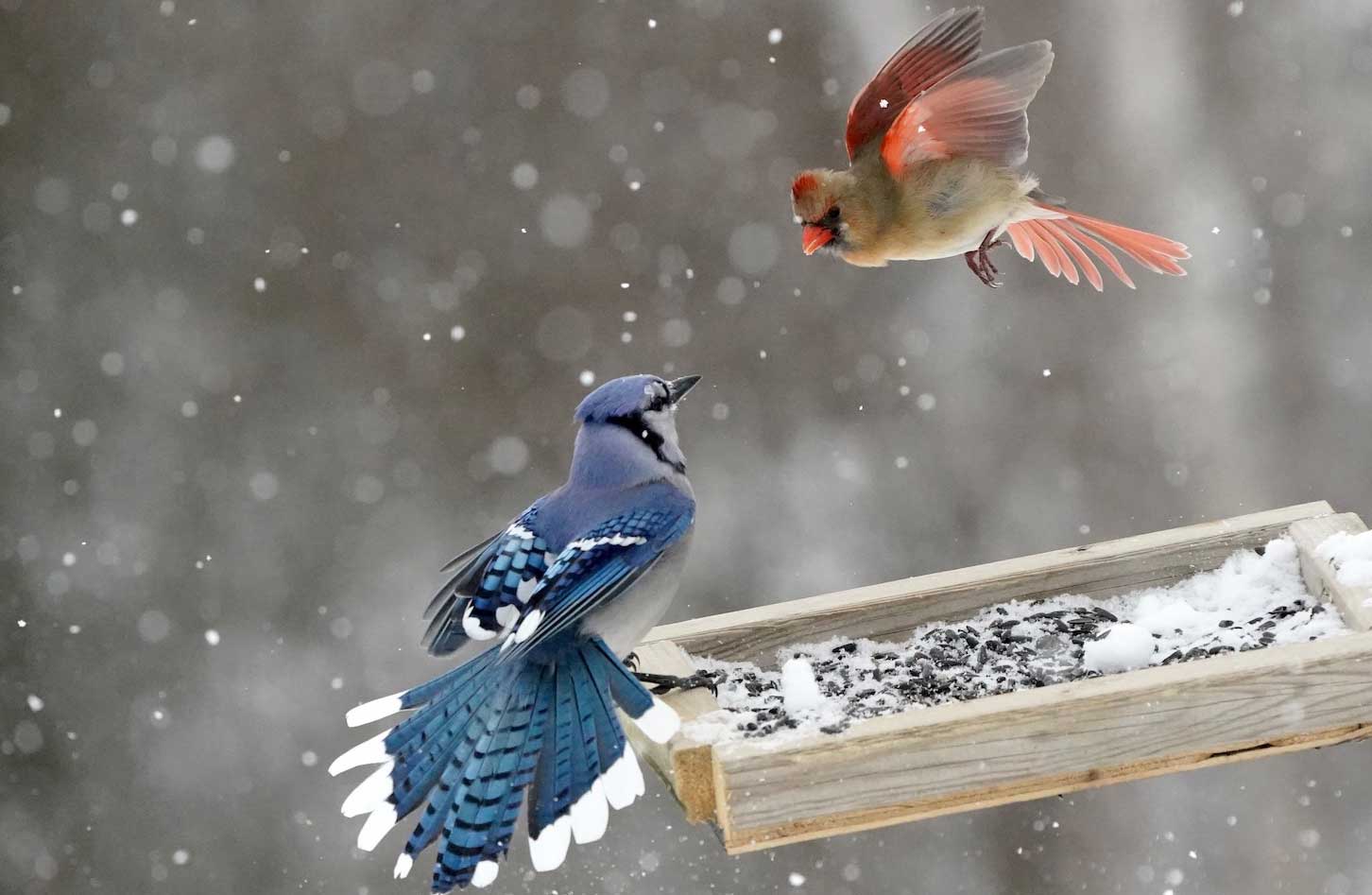Be bird-friendly this winter: How to keep them visiting all season

Now that the days are noticeably colder and shorter, food supplies have become more scarce for many of the birds we see year-round.
Fruit from trees and shrubs is mostly gone, and insects are not as abundant as they were during the warmer months. The birds still need to eat, though, and keeping your bird feeders stocked during late fall and winter can be a big help.
Here are some good bird food choices for winter and some pointers and tips to keep birds visiting your yard for these next few months.
Seeds and nuts
Seeds and nuts are a dietary staple for many birds species, particularly those that remain in cold-weather climates for the winter. Plenty of options are available, but some birds prefer certain kinds of nuts and seeds over others.
Black-oil sunflower seed is the most universal of seeds, eaten by almost all birds that visit bird feeders, according to Bird Watcher's Digest. It's a good choice if you want to attract a variety of birds to your yard. The seeds can be a bit messy, but the already hulled seeds, called sunflower hearts, are a less-messy alternative. Striped sunflower seed is another good choice and can be good for attracting jays and cardinals.
Cracked corn is a good choice for attracting doves, jays, blackbirds and sparrows. Northern cardinals particularly love safflower seed, and thistle is a favorite of finches of all kinds. Peanuts without their shells can attract a bevy of birds. Nuts removed from their shells may attract nuthatches, chickadees, titmice, woodpeckers and jays. Jays and woodpeckers will also eat peanuts in the shell, but smaller birds will not.
A few tips for backyard bird enthusiasts stocking feeders for winter:
- Make sure you use a feeder that is appropriate for the kind of seed or nut you are putting out. For example, thistle seed requires a special thistle feeder because the seed is so small. And many bird feeders are not suitable for peanuts because the nuts are too big.
- If you buy birdseed mixes, look for good mixes that don't have a lot of filler. Quality seed mixes have a high content of black-oil sunflower seeds, cracked corn and white proso millet, according to Bird Watcher's Digest. Avoid seed mixes with a lot of filler ingredients, including wheat and red milo.
- Squirrels love to visit bird feeders for easy access to food. A few food options — notably cracked corn and peanuts — are known favorites of squirrels. On the other hand, safflower seed is not a popular choice for squirrels.
Suet
In the winter, birds need more calories to stay warm, so offering high-fat foods is beneficial because fat has more calories per gram than carbohydrates or protein, according to the National Wildlife Federation. Suet is a good high-fat food for birds because it is readily available and relatively inexpensive.
Another good high-fat option, albeit more expensive, is peanut butter. Peanut butter doesn't come in neat little packs that you can easily pop into a feeder like suet does, but you can simply smear peanut butter on a tree trunk to offer it as a food option. Just be sure the brand is one that doesn't contain partially hydrogenated oil, or trans fat.
High-fat foods like suet and peanut butter are particularly good options for birds that eat a lot of insects in the warmer months. Nuthatches, chickadees and woodpeckers are among the birds that can benefit from the high fat content in suet and peanut butter, according to the Cornell Lab of Ornithology.
Don't forget water
Freezing temperatures can make water hard to come by in winter, and birds need water both to drink and so they can clean their feathers. Offering a steady supply of fresh water can attract birds, the Cornell Lab reports.
Shallow birdbaths are the best choice, but you can also improvise and make your own with objects such as garbage can lids, pie plates or even a frying pan. Just make sure to clean it often and replenish it with water after freezing temperatures.
Feed responsibly
While keeping your bird feeders stocked is beneficial to birds all year long, there are a few things you should do to help keep birds safe and free of disease.
To start, you should give your bird feeders a good cleaning at least a few times a year, the National Audubon Society advises. To get them clean, simply use a solution containing 10 percent non-chlorinated bleach and scrub all parts of the feeder. Make sure to let the feeder dry completely before refilling it. To keep your feeders clean all year long, clean them between seasons.
You should also regularly rake or clean up the seed that has fallen to the ground, Treehugger reports. The fallen seed can get wet and soggy and sprout mold, which can make birds sick.
When filling feeders, put separate types of seed in separate feeders, the Audubon Society recommends. For example, put black-oil sunflower seed in one feeder and cracked corn in another. Keeping seeds in separate feeders helps keep bird species that don't usually interact separate and also keeps waste and mess to a minimum.
If you have multiple bird feeders in your yard, consider putting some distance between them and keep them at different heights. This will also help keep different species from interacting and decrease the likelihood of the spread of disease.
